How to move Home Assistant server from microSD card to SSD
If you use a Raspberry Pi for a Home Assistant server installed on a microSD card, you may start to experience performance issues as you add more things and install or run multiple add-ons, such as Plex media server or Samba, or use it as an NVR (Network Video Recorder).
However, you can quickly move your existing Home Assistant server from a microSD card to an SSD and boot Home Assistant on a Raspberry Pi 3 or 4 from there. This option will be much faster and more reliable, and SSDs offer greater capacity at a significantly lower price than SD cards of the same performance.
Methods to move Home Assistant server from SD card to SSD
There are two reliable ways to move your Home Assistant server from microSD card to SSD.
1. Backup, reinstall and restore the Home Assistant server.
2. Create a Home Assistant server image and write it to the SSD.
3. You can use an external or internal SSD (in a USB enclosure) of any size. The example is using a Samsung 500 GB SSD to run the Home Assistant server because the server is also used as a surveillance NVR to record CCTV footage from IP cameras based on motion. Both NVMe and SATA SSDs will work as long as they have a USB port to connect to.
Additionally, you must enable USB boot on the Raspberry Pi 3 or 4 that you are using for your Home Assistant server.
Below, the article will guide you in detail on both methods to help you move Home Assistant or any other server or operating system from SD card to SSD completely and without any risk of loss. any data. Make sure to follow either of these methods in the order available.
Method 1: Backup, reinstall, and restore Home Assistant
This is the recommended method to move Home Assistant server from microSD card to SSD. This method includes three steps.
Step 1: Create a backup of the Home Assistant server
On your Home Assistant server, go to Settings > System > Backups and click the Create Backup button .
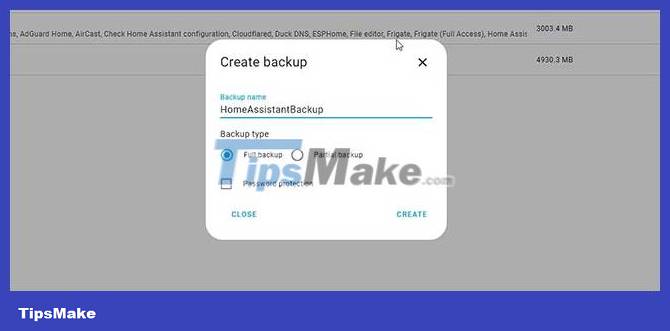
Enter a name for the backup, select the Full backup option and click Create. Wait for the backup to be created. This may take a while to complete. When the backup process is complete, click on the name of the backup and then click on the three dots, select Download backup.
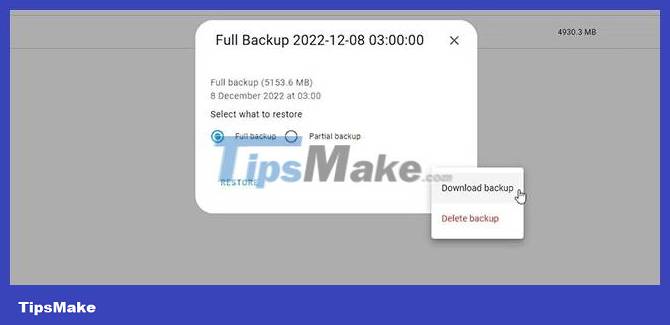
This will download the Home Assistant backup to your local storage.
Step 2: Flash image Home Assistant on SSD
Download the same version of Home Assistant running on a microSD card and use the Raspberry Pi Imager tool to flash the image to the SSD.
1. Launch the Raspberry Pi Imager tool
2. Select the Home Assistant OS image in Choose OS , the connected SSD in Choose Storage and click Write.
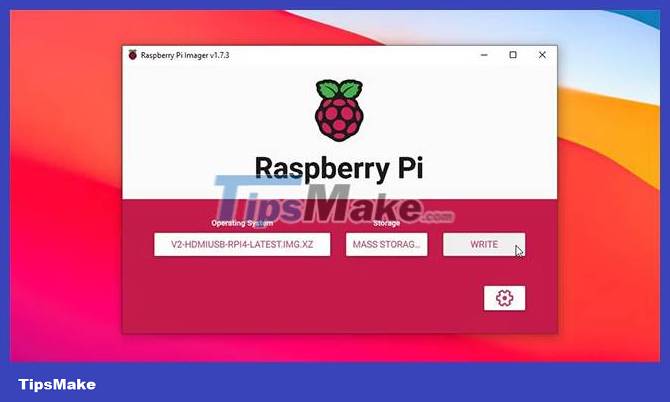
3. Connect the SSD to the USB port of Raspberry Pi 3 or 4 and connect the power source.
4. If you have enabled USB boot on the Raspberry Pi, Home Assistant will boot from the connected SSD. Since it's the first boot, it will take a while to complete.
Step 3: Restore the backup
When the Home Assistant installation is complete on the SSD, you will see the option: "Alternatively, you can restore from a previous snapshot" .

Click on it and then select the backup that you downloaded on your local storage. Click Restore Selected . The backup will upload to your Home Assistant server running on SSD and restore it. During this process, your server will be offline for a while. This process may take a few minutes based on the size of the Home Assistant backup, so sit back and relax.
When the server is restored, the web interface will automatically load. At this stage, you have successfully migrated the Home Assistant server running via microSD card to SSD.
Method 2: Create a Home Assistant image from the SD card and burn it on the SSD
You can copy the current Home Assistant server as an image file from a microSD card using the Win32 Disk Imager tool, then flash this image to the SSD using the Raspberry Pi Imager tool. The steps are as follows:
1. Turn off the Raspberry Pi and disconnect the microSD card.
2. Use a card reader to connect the microSD card to the PC.
3. Download, install and launch the Win32 Disk Imager tool.
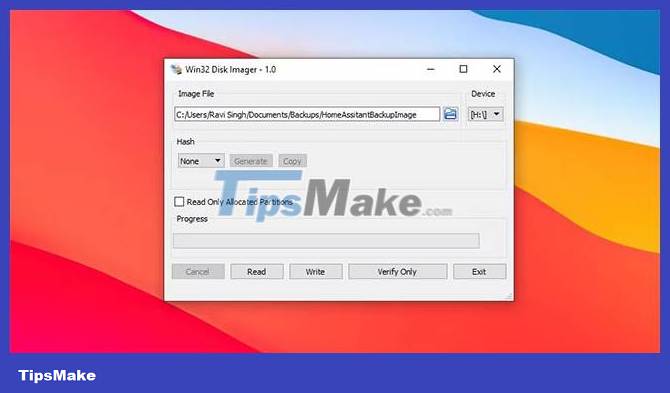
4. Click the folder icon to select the location where you want to save the Home Assistant backup image file. Enter a name for the file and click Open.
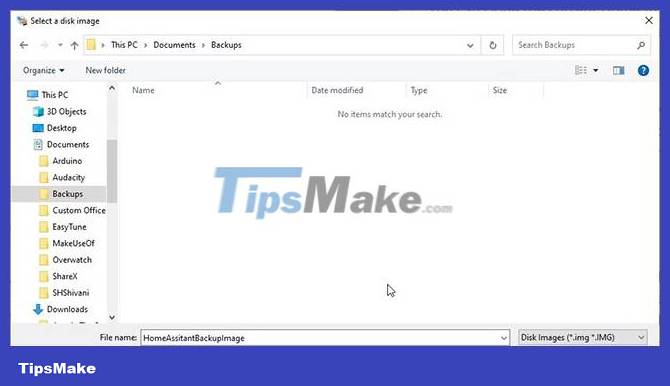
5. Select the drive letter in Device options and click Read.
6. The tool will create an image file containing data information and the Home Assistant partition. This process will take a while to complete depending on the size of the microSD card and its reading speed.
7. The estimated time will be displayed in the bottom right corner.
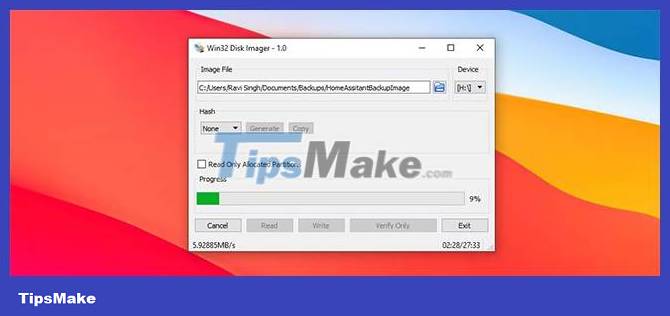
8. Once the image is created, launch the Raspberry Pi Imager tool.
9. Click Choose OS and select the image file you just created.
10. Click Choose Storage and select the connected SSD.
11. Click Write. Confirm if prompted.
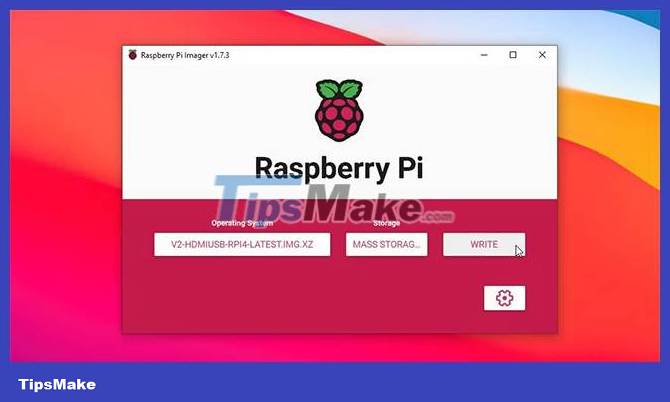
12. After the image is written on the SSD, connect the SSD to Raspberry Pi 3 or 4 by activating USB boot and powering on the device.
13. Home Assistant will start and you can continue to use the server normally as if it were running on a microSD card but with larger storage capacity and faster performance.
You should read it
- Whoever plays the game is ready to buy HyperX microSD card
- How to choose the appropriate MicroSD card for Nintendo Switch
- How to choose to purchase microSD card to upgrade Android memory
- The world's fastest 1.5 TB microSD card
- How to detect fake microSD card
- Mistakes or mistakes when buying MicroSD cards
- The world's first 1TB microSD memory card costs $ 449
- How to Remove Write Protection on a Transcend microSD Card
May be interested
- How to Remove Write Protection on a Transcend microSD Card
 have you ever received an error message about whether the memory card is in write-protected or read-only mode when copying data to the card? this error can interfere with editing and moving important files, making it difficult to perform tasks on the microsd card. fortunately, there are many different solutions for you to deal with this problem, ranging from simple to complex. today's tipsmake will show you how to fix the error that reads and writes data only to the transcend microsd card.
have you ever received an error message about whether the memory card is in write-protected or read-only mode when copying data to the card? this error can interfere with editing and moving important files, making it difficult to perform tasks on the microsd card. fortunately, there are many different solutions for you to deal with this problem, ranging from simple to complex. today's tipsmake will show you how to fix the error that reads and writes data only to the transcend microsd card. - Learn about Home Assistant - Your home automation platform!
 home assistant is an open source home automation platform that runs on python 3.x, designed to be easily deployed on any computer from raspberry pi to network storage devices (nas) and even a docker container to deploy on other systems easily.
home assistant is an open source home automation platform that runs on python 3.x, designed to be easily deployed on any computer from raspberry pi to network storage devices (nas) and even a docker container to deploy on other systems easily. - Samsung launches new 256GB SD Express microSD memory card, supporting 800MB/s read speed
 in a press release, samsung revealed that it has begun production of 256gb microsd memory card products based on the sd express standard, also the company's first line of microsd memory cards to support this standard.
in a press release, samsung revealed that it has begun production of 256gb microsd memory card products based on the sd express standard, also the company's first line of microsd memory cards to support this standard. - Experience the feeling of holding 400GB of data on your fingertips
 many technological items - from a pc with an 18-core processor to a super-sized vr headset - will be presented at the ifa event in berlin, germany. but maybe a few items match the sandisk 400gb microsd card.
many technological items - from a pc with an 18-core processor to a super-sized vr headset - will be presented at the ifa event in berlin, germany. but maybe a few items match the sandisk 400gb microsd card. - Storage drop brakes with new microSD memory card of Integral Memory 512GB capacity
 if 400gb is still not enough, integral memory has recently announced it will release a 512gb microsd card.
if 400gb is still not enough, integral memory has recently announced it will release a 512gb microsd card. - What is microSD Express memory card?
 performance is always a problem with memory cards and microsd express promises to make memory cards much faster. so what is it, why is it faster than other cards? let's find out in the following article.
performance is always a problem with memory cards and microsd express promises to make memory cards much faster. so what is it, why is it faster than other cards? let's find out in the following article. - SanDisk sold the world's first 1 TB microSD memory card, costing more than VND 10 million
 the world's first 1 tb microsd memory card was marketed by sandisk for the same price as an ipad air or iphone 8 plus.
the world's first 1 tb microsd memory card was marketed by sandisk for the same price as an ipad air or iphone 8 plus. - What is a TF card? How is it different from a microSD card?
 of these options, tf cards and microsd cards are the most commonly used for external storage, with many gadgets using them as primary or secondary memory.
of these options, tf cards and microsd cards are the most commonly used for external storage, with many gadgets using them as primary or secondary memory. - 3 ways to increase storage capacity on Android with a microSD card
 many android phones have very little storage, in which the operating system has up to 6gb. however, android 6.0 mashmallow or newer phones can increase memory capacity by using microsd cards.
many android phones have very little storage, in which the operating system has up to 6gb. however, android 6.0 mashmallow or newer phones can increase memory capacity by using microsd cards. - Nano memory card memory card, solution for smartphones not equipped with memory card slot
 at the launch of the mate 20 smartphone launch in london, huawei mate introduced a new enhancement to storage memory. it is nano memory card, memory card in the format of a nano-sim card, with a capacity of up to 256gb.
at the launch of the mate 20 smartphone launch in london, huawei mate introduced a new enhancement to storage memory. it is nano memory card, memory card in the format of a nano-sim card, with a capacity of up to 256gb.










 How to use Ubuntu Core on Raspberry Pi
How to use Ubuntu Core on Raspberry Pi How to create a new user in Raspberry Pi OS
How to create a new user in Raspberry Pi OS 8 things to avoid to not damage your Raspberry Pi
8 things to avoid to not damage your Raspberry Pi Difference between Elegoo and Arduino
Difference between Elegoo and Arduino 4 reasons to buy an old Raspberry Pi model
4 reasons to buy an old Raspberry Pi model Why is the new Arduino Uno R4 a game changer for manufacturers?
Why is the new Arduino Uno R4 a game changer for manufacturers?